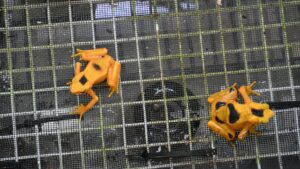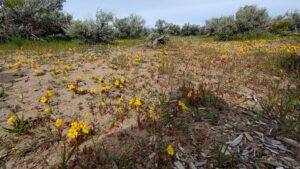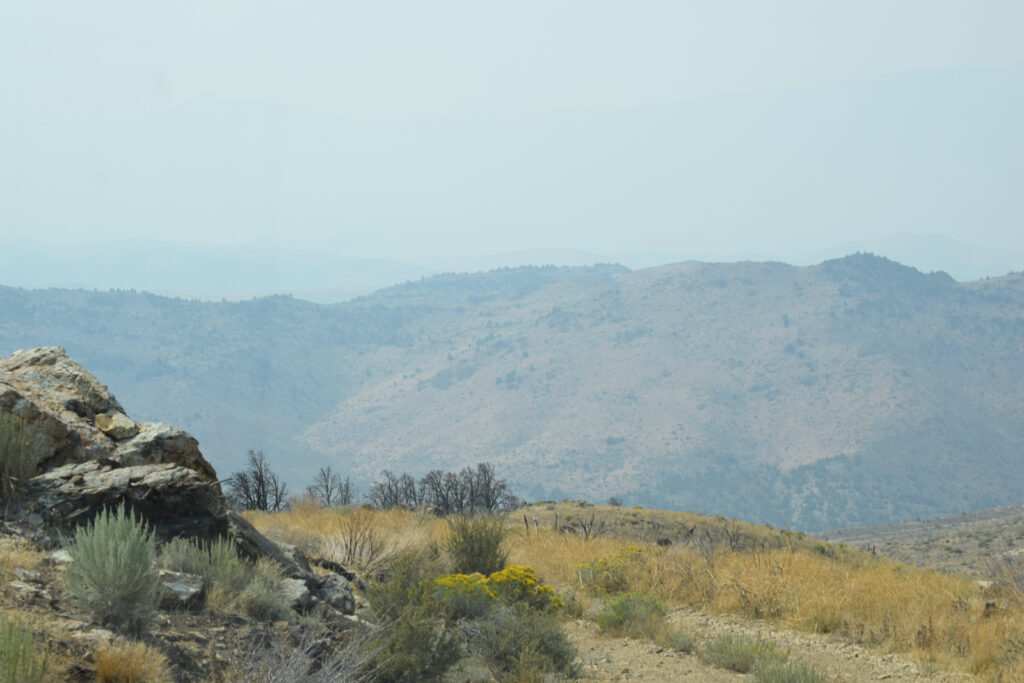
This story was produced through a collaboration between KUNR Public Radio, the nonprofit science and newsgroup Climate Central, and the Hitchcock Project for Visualizing Science at UNR. For the audio version of this story, please visit the website of KUNR Public Radio.
The U.S. Forest Service halted their prescribed burns this summer following an out-of-control burn in New Mexico that became the worst wildfire in the state’s history. Moreover, for Nevada land managers — including many with ties to local tribes — climate change is making it more difficult to put “good” fire on the ground.
In the Pine Nut Mountains on Washoe tribal land in northwestern Nevada, a pinyon-juniper forest grows out of control.
Rhiana Jones and Billy Hawk Enos are land management experts from the Washoe Environmental Protection Department. They survey the patch of forest, pointing out the subtle signs of its decline.
The pines grow almost on top of each other, and many are dead from disease and drought. The forest carpet is ankle-deep, covered in fallen needles, twigs, and branches — fine fuels that would feed a fire. The dry timber could easily go up in flames.
And it’s eerily quiet. “It’s not so much what you’re hearing out here — it’s what you’re not hearing,” says Jones. “There’s no birdsong. No animals.”
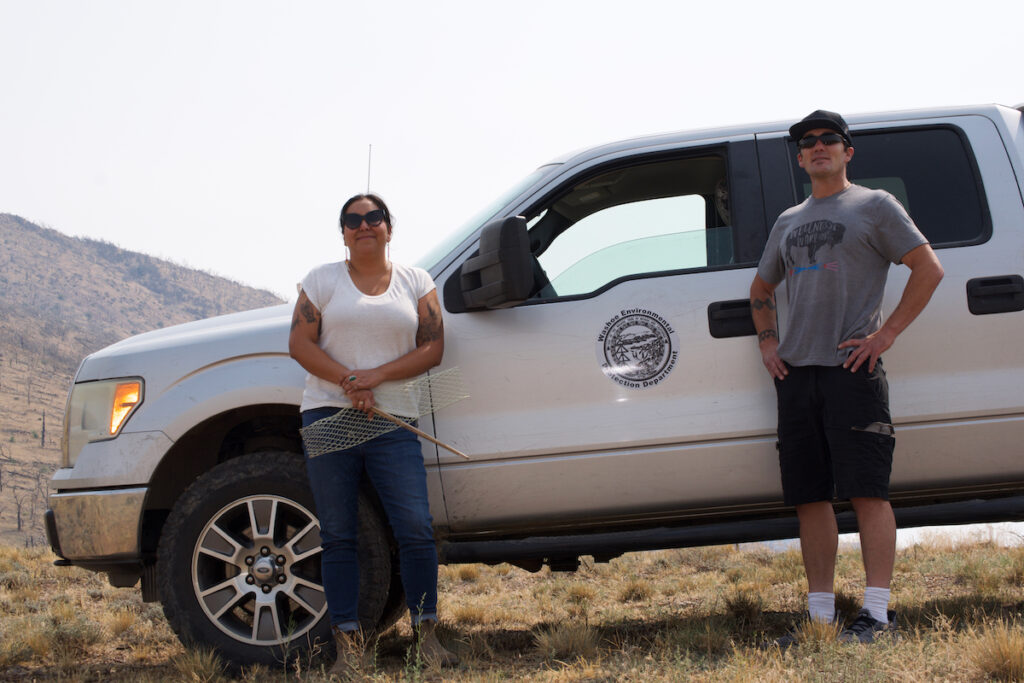
The Washoe People would like to treat the land with fire to prevent environmental disasters like these — but they can’t. The tribe hasn’t been able to set a fire for at least a decade.
In the early 20th century, sweeping fire suppression became the law of the land with the passage of the Weeks Act of 1911. Today, the same federal agencies that subjugated cultural burners are learning their techniques, which Indigenous groups refined over the course of thousands of years. The lands their ancestors managed with fire have deteriorated.
As these agencies attempt to play catch-up after more than a century of fire suppression, the effects of heat-trapping pollution are making it harder for them to use a key Indigenous tool for reducing fire risk.
The combination of warm, windy, and dry conditions creates “fire weather” days, which can whip small fires into infernos. These days occur far more often than they used to. Science and news nonprofit Climate Central analyzed historical weather records, finding that the area around Lake Tahoe — including Reno — experiences an additional month of fire weather days annually compared to a half-century ago.
Across Nevada, forestry officials – including the Washoe – report that these conditions have stymied efforts to get “good fire” on the ground by increasing the risks that controlled burns will get out of control.
Scientists and government officials say climate change and out-of-control vegetation make prescribed fire harder to use
This summer, the U.S. Forest Service suspended all prescribed burns on the agency’s 193 million acres of land — roughly the size of Texas — citing safety concerns stemming from changing weather conditions. This decision arrived after a planned burn went wrong in New Mexico. The Hermit’s Peak Fire ignited in April and was still burning in August when fire officials declared it contained.
This fire was the largest and most destructive wildfire in the state’s history. From April to August, the fire burned 341,471 acres, destroying nearly 1,000 buildings. According to the U.S. Forest Service’s latest incident review, the prescribed fire burned under much drier conditions than had been expected.
Persistent drought and fuel accumulation ruined the agency’s plans to burn further into the summer. These plans are often made months to years in advance.
“Although prescribed fire is one of the most effective ways to reduce wildfire risk, this was a necessary decision in light of recent prescribed fire escapes,” U.S. Forest Service Chief Randy Moore wrote in a national directive in September, announcing the agency would resume prescribed burns following the pause. “This also reflects the growing recognition that extreme conditions of overgrown forests, climate change, and more than a century of rigorous fire suppression are influencing fire behavior in ways we had never seen before.”
Daniel Swain is a climate scientist at UCLA studying how climate change is affecting the viability of prescribed fire across western states. An advisor to Climate Central’s fire weather analysis, Swain says the findings are conservative because they don’t account for how changing weather conditions dry out landscapes in the long term.
“In addition to seeing more extreme fire weather, we’re also seeing more favorable pre-conditions that actually drive large and intense wildfires,” Swain said. “That’s because the vegetation is drier than it used to be and more flammable than it used to be.”
Prescribed fire is an important tool to help reduce the risk of the uncontrollable, high-intensity wildfires that are common today by mimicking lower-intensity fires that used to occur naturally from lightning strikes or under the stewardship of tribes. Ultimately, Swain believes if agencies are more observant about the ecosystems they’re trying to burn, they will be able to continue to use prescribed fire successfully.
Nevada is in the grip of a megadrought, which has been amplified by the effects of heat-trapping pollution — the worst period of extreme dryness and heat in 1,200 years. Against the backdrop of worsening fire weather conditions, Reno is also the epicenter of an invasion of a weed grass species that makes firefighting and prevention even more difficult.
Cheatgrass, which firefighters have nicknamed “grassoline” for its incendiary nature, replaced a healthy old-growth pinyon-juniper woodland on the scorched earth that spreads throughout the Pine Nut Mountains. Many large fires have overlapped here, including the Numbers Fire of 2020, the Preacher Fire of 2017, and — most recently — the Tamarack Fire of 2021.
John Abatzaglou, who researches how climate interacts with natural resources at the University of California, Merced, and who also advised Climate Central on its fire weather analysis, says this region of Nevada is at the heart of America’s cheatgrass problem.
“Cheatgrass tends to invade recently disturbed areas, including those that had fire,” says Abatzaglou. “This results in a feedback loop where fire begets more fire.”
Climate change helps the invasion by disturbing the landscape with drought and altered fire regimes, which creates an advantage for cheatgrass to get a better hold in the landscape. Higher temperatures are projected to push cheatgrass further north and to higher altitudes, where the noxious weed couldn’t previously survive.
“It creates a nasty situation, and now we’re trying to figure out if we can solve it with prescribed fire,” says Abatzaglou. “That alone isn’t gonna do it, but it can be one tool to help.”
Abatzaglou expects that the Sierra Nevada could begin to see fires start at cheatgrass-dominated lower elevations, then extend all the way up to higher elevations that are newly colonized by cheatgrass.
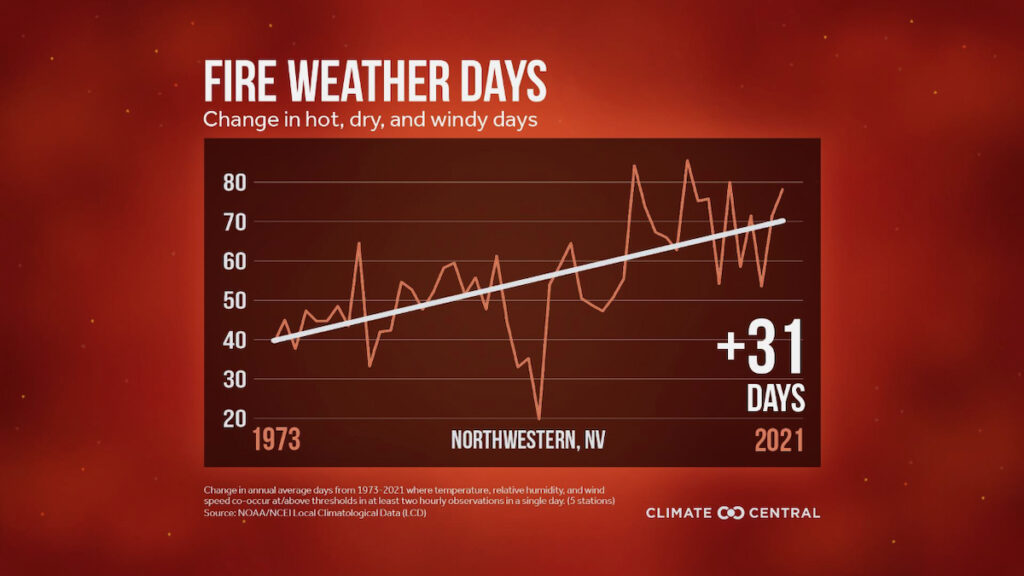
An out-of-control prescribed fire traumatized Nevadans, but state officials are still committed to the tool
Late on a windy October night, cinders blew from a prescribed burn in the Whittell Forest & Wildlife Area to Little Valley: a small, unincorporated community about 25 miles south of Reno and just north of Carson City. During the coming three days, the wildfire they sparked consumed more than 2,300 acres and destroyed 40 buildings.
Little Valley rancher Mary Ann Healy didn’t expect to get out of bed that night. The scanner on her nightstand brought alerts for the community’s volunteer firefighters, including her late husband, Jack; he usually returned within a couple of hours of departing on emergency calls.
But Healy says this time it was different. “This might be bad,” Jack told her before leaving to wake their neighbors. “Go turn on the sprinklers.”
Embers from the Nevada Division of Forestry’s out-of-control burn had washed over Little Valley. “The towering flames were visible from [afar],” said Healy. “There were huge flames — huge. Oh my goodness.”
Healy and her son fled the fire to an evacuation point at Bowers fire station near Carson City — but something made her turn around. The Healys raise hay and Irish draft horses, which escaped during the fire. The pitch-black horses blended into the smoky night, so the family decided to open the gates to their pasture to permit the animals their own chance to leave.
At the station, Healy could hear firefighters talking about a ranch over the dispatch: “Horses loose on Franktown Road — horses loose on 395.”
“And I was saying, ‘Oh God, please don’t let it be mine.’ And it was. Those were my horses loose on Route 395. A neighboring rancher saw them out there. They were just grazing along the highway,” she added. “Some yo-yo firemen cut back the fence, but our horses would have been totally safe out in our 60-acre pasture.”
Upon returning to the ranch, Healy and her son attempted to hitch a trailer to her pickup truck that would help her recover her horses.
“I said, ‘Let’s get this thing hooked up and get it out of here.’ No sooner did I start to back up to hook it up that the [trailer] caught fire. Then it was gone.”
An investigation by the Reno Gazette-Journal found that the primary factors that caused the prescribed burn to escape the NDF’s control were understaffing and perilously strong winds.
Little Valley was home to many elderly people, and since the 2016 fire, many have passed away — like Jack Healy. Others have given up on Nevada and its intense fire seasons and moved away.
In spite of the tragedy that took her home, Healy does not identify herself as an opponent of prescribed fire — though she also supports the government using other methods to intervene on the landscape.
“Yes, we need control burns,” says Healy. “But we also need to log, we need to let cattle in [to graze] areas such as Little Valley. If you’re not going to [treat] areas, you’re setting yourself up for fires from lightning strikes and the like.”
The Nevada Department of Forestry used to regularly burn several hundreds of acres annually — peaking at 1,319 acres the year before the Little Valley Fire. But in the years following the fire, the acreage treated with prescribed burns has sharply tapered off.
Kacey KC, the state’s chief forester and fire warden, says that it’s not just climate change that limits prescribed burns. Like the federal government, the NDF’s workforce and budget are stretched thin, with limited capacity to treat land before wildfires strike.
“We’ve just had very few windows where all of the stars aligned for the right conditions this year,” she said. “Part of that is due to weather windows. Part of that is due to an unprecedented number of vacancies in our agencies and qualified staff to do this type of burn.”
KC, who took her post after the Little Valley Fire, points out that 2022’s record-breaking, hot and dry summer did not stop the NDF from burning. But escalating fire weather conditions are making it more difficult for the agency to plan future burns, which state fire specialists often organize up to five years in advance.
“Even if we hit the right weather window,” KC said, “we won’t always go forward.”
So far, the NDF is behind schedule on its annual burn plans. The agency hopes to put more fires on the ground through the end of the year, but resources are stretched thin and time is running out before the arrival of windy conditions that make it challenging to burn.
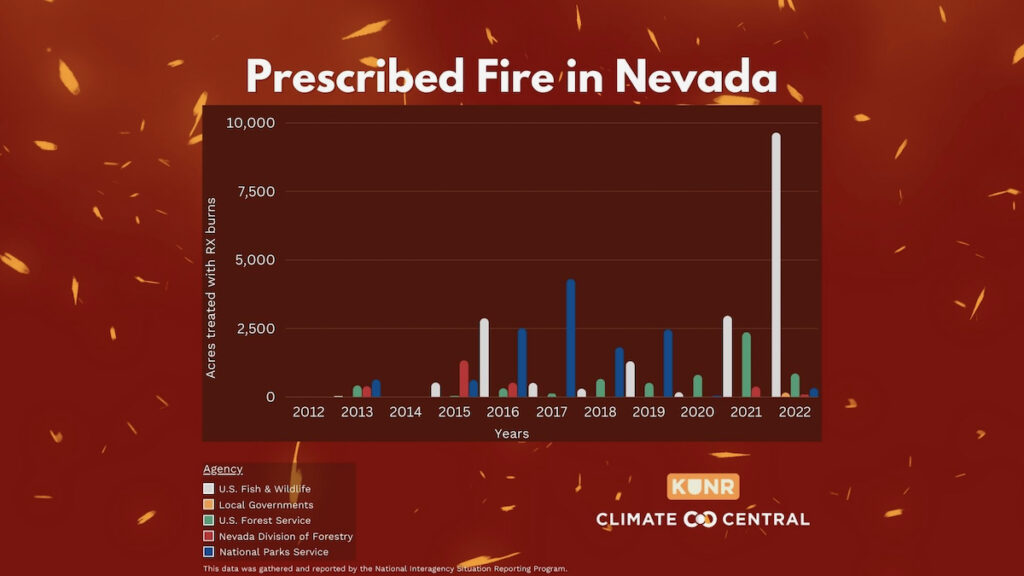
Forests thrived under Washoe stewardship, and the tribe says traditional knowledge can inform restoration
A team of Washoe forestry experts, including Rhiana Jones and Billy Hawk Enos, are working to restore a pinyon-juniper forest to where hot and wild fires have charred the land.
Flames helped the Indigenous people who lived on land now known as Nevada manage the forests that sustained them — at least, when they would set fire to the forest on purpose.
Over thousands of years, the Washoe People harvested nuts from the pine trees each fall — bags and bags of them — to eat during the bitter Sierra winters.
“In this area, pinyon pine was one of the main sources of food for the Washoe People,” said Jones. “Lake Tahoe used to be the center of the Washoe homelands. Then they were forced out of Tahoe [by non-Indigenous settlers in the mid-1800s] so they didn’t have access to the fish, to their medicinal plants anymore. So they would survive the whole winter on pinyon nuts.”
And while they did, they had fires running 24/7. “They’d comb all the dead branches out [of the forest],” said Enos, “And that’s what they’d burn.”
Pinyon-juniper woodlands are in decline all over western states, and wildfire is a factor. The Washoe People host an annual pine nut festival and blessing, but Jones says they’ve had to pivot from using actual pine nuts, which have become scarce.
Enos recalls cracking open the cone of a single-leaf pinyon pine and finding only one nut in the entire cone.
“Out there, we’re not finding even, like, 10% of what we would normally get,” said Jones.’
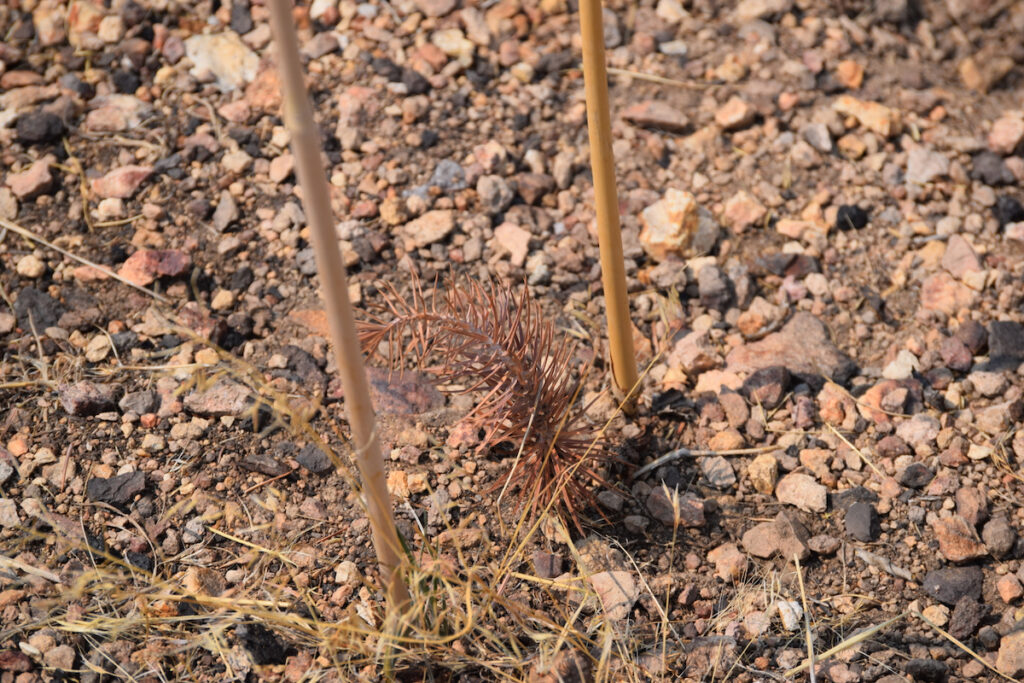
According to UNR biologist Robert Shriver, there are a variety of reasons for the decline of the single-leaf pinyon. As it gets warmer and drier, the density of trees a landscape is able to support lessens. But the broader problem is that the species’ ability to reproduce is faltering, which is something Shriver calls “low recruitment.”
“We’ve known that die-offs have been occurring in pinyon-juniper woodlands across the west since about the early 2000s,” said Shriver. “There’s really been a big question about what that means for long-term population viability. So whether or not the species can persist depends on the survival [of mature trees], but then also on whether or not there’s new trees coming in to replace the ones that are dying.”
Pinyon pines are vulnerable to a wide variety of diseases and parasites that weaken the species’ ability to “recruit” more trees: Black stain root disease can kill seedlings within a year of infection. Pinyon needle rust can destroy enough foliage to disfigure or slow the growth of young pines. Pinyon dwarf mistletoe is a parasite that can kill seedlings outright — but it can also weaken mature trees by robbing them of precious water and nutrients, thereby preventing them from producing adequate seed.
The NDF suggests that fire is an effective treatment for infected twigs and branches, which must be disposed of quickly before they can infect other trees.
Long ago, the forests around Dresslerville yielded enough pine nuts to sustain pinyon jays and the Washoe People who lived there. Artifacts like tools and stone rings from their ancient encampments are still there, but wildfire has revealed them to thieves and the elements. Today, the stands of pinyon pines are nearly sterile.
Jones’ department is urging festival goers to go out into the forest and help collect pine nuts — but for seedstock rather than food.
“We’ve been collecting them like crazy,” said Jones. “Going much farther outside of our traditional territory than we normally would to find this resource. We’re working with other tribes because this resource is not only important to the Washoe; it’s important to the Paiute. We all realize we need to go into a state of emergency to save the pinyon pine.”
Forest restoration is informed by traditional ecological knowledge, which are practices Enos has learned about from Washoe elders and cultural burners from other California tribes. And Enos believes that another traditional practice – the application of planned burns – is essential to its success.
Enos says setting the understory below the pinyon pines and the juniper forest alight would remove “all the pests, all the disease.”
“Our elders say, when they would burn, it makes the garlic and the onions taste a lot better,” said Enos. “The pine nuts also — it makes them bigger and juicer.”
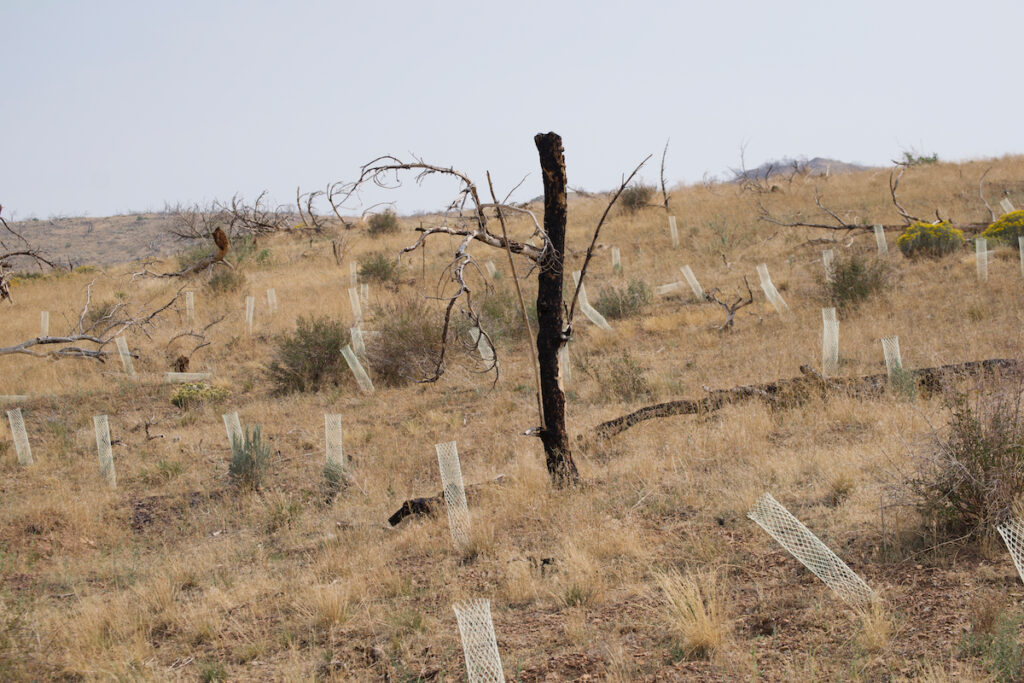
But not everybody supports the use of prescribed fire, and fear of the practice grows every time one gets out of control. Jones believes that land managers must take the highest precautions when working with this tool, but she’s frustrated with the U.S. Forest Service’s decision to suspend prescribed burns across its vast holdings.
“That’s what got us into this situation in the first place,” said Jones. “I don’t think it should stop completely because that’s basically what’s happened in the past, what, 50, 100, 200 years? Now we don’t even know what a healthy forest looks like because there aren’t any around.”
No culturally-guided fires have touched Nevada forests in at least the last decade, but the Washoe Environmental Protection Department says it hopes to light the first “good fire” by the year’s end.
Climate Central’s Kaitlyn Trudeau contributed data reporting.
Text description of Graphic 1, Fire Weather Days:
A line graph indicating the increase in hot, dry, and windy “fire weather” days in northwestern Nevada from 1973 to 2021.
In 1973, there were approximately 40 fire weather days. The consecutive data points on the line include approximately 45, 38, 48, 45, 45, 48, 45, 65, 34, 42, 42, 55, 54, 49, 59, 60, 50, 55, 49, 61, 33, 35, 20, 54, 65, 50, 47, 55, 85, 67, 65, 63, 85, 75, 76, 55, 80, 59, 71, 54, and 71 fire weather days. The final data point on the line, representing the year 2021, is 79.
These data points show the change in annual average days from 1973 to 2021, where temperature, relative humidity, and wind speed co-occur at or above thresholds in at least two hourly observations in a single day.
Source: National Oceanic and Atmospheric Administration / National Centers for Environmental Information Local Climatological Data.
Text description of Graphic 2, Prescribed Fire in Nevada:
A bar graph demonstrating prescribed fire in Nevada. The y-axis of the graph represents acres treated with prescribed fire. The x-axis of the graph represents the years Nevada agencies burned. The key lists the following agencies: the U.S. Fish and Wildlife Service, local governments, the U.S. Forest Service, the Nevada Division of Forestry, and the National Parks Service. This data was gathered and reported by the National Interagency Situation Reporting Program.
In 2012, no agencies were recorded to have burned any acres.
The U.S. Fish and Wildlife Service is recorded to have burned the following acres:
- 35 acres in 2013
- 0 acres in 2014
- 522 acres in 2015
- 2,858 acres in 2016
- 510 acres in 2017
- 300 acres in 2018
- 1,294 acres in 2019
- 170 acres in 2020
- 2,951 acres in 2021
- 9,637 acres in 2022
Local governments are reported to have burned no acreage up until the year 2022, in which they burned 161 acres.
The U.S. Forest Service is recorded to have burned the following acres:
- 410 acres in 2013
- 0 acres in 2014
- 41 acres in 2015
- 315 acres in 2016
- 139 acres in 2017
- 654 acres in 2018
- 513 acres in 2019
- 796 acres in 2020
- 2,348 acres in 2021
- 854 acres in 2022
The Nevada Division of Forestry is recorded to have burned the following acres:
- 383 acres in 2013
- 0 acres in 2014
- 1,319 acres in 2015
- 520 acres in 2016
- 0 acres in 2017
- 0 acres in 2018
- 14 acres in 2019
- 0 acres in 2020
- 376 acres in 2021
- 90 acres in 2022
And the National Parks Service is recorded to have burned the following acres:
- 623 acres in 2013
- 0 acres in 2014
- 616 acres in 2015
- 2,495 acres in 2016
- 4,292 acres in 2017
- 1,800 acres in 2018
- 2,450 acres in 2019
- 44 acres in 2020
- 4 acres in 2021
- 328 acres in 2022

